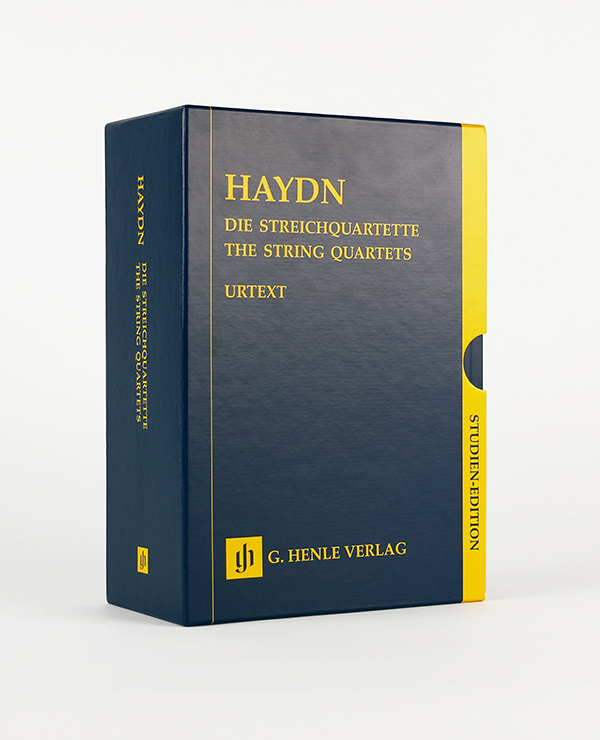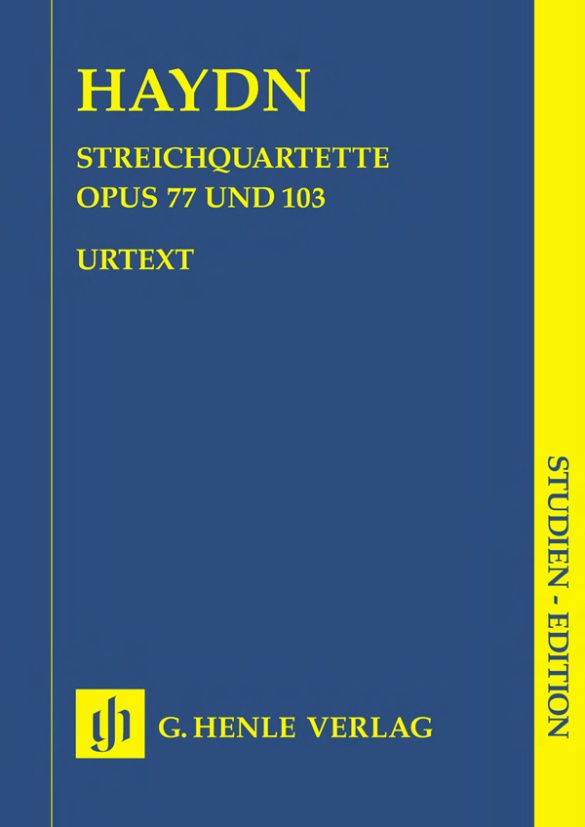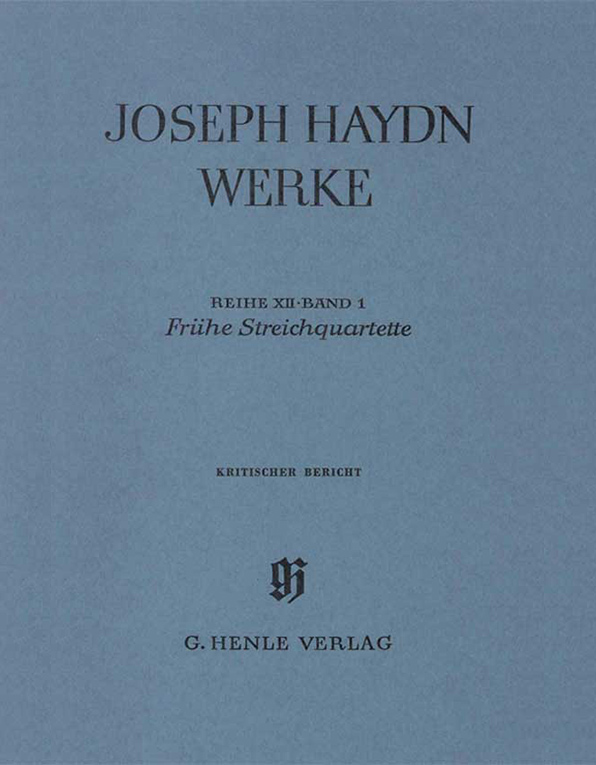Joseph Haydn
The String Quartets - 12 Volumes in a Slipcase
On the occasion of Haydn’s anniversary year 2009, we have a particular highlight: all of Joseph Haydn’s 69 string quartets, in 12 paperback editions, collected together in an extremely affordable slipcase.
All of the study scores minutely follow the musical text contained in the uncontested reference edition by the Joseph Haydn Institute in Cologne, whose scholarly critical Haydn Complete Edition is also published by Henle Publishers. Each quartet opus reflects the latest in scholarly research and is introduced by an informative preface. The musical text fulfils the highest aesthetic demands. A welcome present for every chamber music fan and the basis for every serious quartet player who wishes to play or study these works.
Content/Details
About the Composer
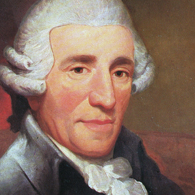
Joseph Haydn
His immense oeuvre documents the profound changes in music history during the second half of the eighteenth century, leading to the emancipation of instrumental music. His most important genres are the symphony and the string quartet, where he cultivated the technique of motivic-thematic development; he made significant contributions to the instrumental concerto and to piano music; during the last years of his life, he composed his great oratorios. Opera and art song take on a rather subordinate significance.
| 1732 | Born in Rohrau, probably on March 31 (baptized on April 1). |
| 1737 or 1738 | His uncle Johann Mathias Franck takes him in, in order to oversee his musical education. |
| around 1739/40 | For about 8–10 years, chorister at St. Stephen’s Cathedral in Vienna. |
| from 1750 | He makes his living as a musician, teacher, and composer. |
| 1757–61 | Employed as music director by Count Morzin. He makes a name for himself as a composer: fifteen symphonies, piano sonatas, trios, divertimenti, string trios, wind partitas, string quartets Opp. 1 and 2. |
| 1761 | “Times of Day” Symphonies Nos. 6–8: “Le matin,” “Le midi,” “Le soir.” |
| from 1761 | Employed by Prince Paul Anton at the Esterházy court, by Prince Nikolaus from 1762, by Paul Anton II from 1790–96, then by Nikolaus II, first as vice-Kapellmeister, then as Kapellmeister after 1766. |
| 1764–65 | Symphonies No. 22 in E-flat major, “Philosopher”; No. 30 in C major, “Alleluia”; and No. 31 in D major, “Hornsignal.” |
| 1766 | Prince Nikolaus Esterházy demands operas for the theater in his newly erected castle. Haydn’s operas are written primarily for special occasions, e.g., “La Canterina,” for the Kaiser’s visit in 1766. He composes many baryton pieces for Prince Nikolaus. |
| 1766–74 | Eighteen symphonies, including “La passione” in F minor (1768), “Lamentatione” in D minor (1770), “The Schoolmaster” in E-flat major (1774), “Trauer” (“Mourning”) in E minor (1772): expanded expressive range (six are in minor keys), more counterpoint. |
| 1768 | Premiere of “Lo speziale” on Goldoni’s libretto for the inauguration of the new opera house at Eszterháza. |
| 1770 | Premiere of the dramma giocoso “Le pescatrici.” After a ten-year hiatus, he writes the pioneering string quartets “6 Divertimenti” Op. 9, and Op. 17 (1771). |
| 1771 | Piano Sonata No. 20 in C minor. |
| 1772 | “Farewell Symphony” No. 45 in F-sharp minor, “6 Divertimenti (‘Sun Quartets’),” Op. 20, which are characterized by contrapuntal techniques (some have fugues as final movements). |
| 1775 | Premiere of the opera “L’incontro improvviso.” |
| around 1775–78 | “Missa brevis sancti Joannis de Deo (‘Little Organ Mass’).” |
| 1776 | Prince Nikolaus calls for regular opera performances at Eszterháza. Haydn adjusts works imported from Vienna or Italy to the local taste. He moves from Eisenstadt to Castle Eszterháza, where he resides for ten months a year. Little instrumental music after 1776, often with integrated opera music. |
| 1777 | Premiere of “Il mondo della luna,” after Goldoni. |
| 1779 | Contact with the publisher Artaria, who distributes his compositions over the following decade. |
| 1781 | Premiere of the opera “La fedeltà premiata.” Missa Cellensis, “Mariazellermesse”; String Quartets, Op. 33 (‘Russian Quartets’), which are written “in a quite new and special way” (Haydn) after a rather long break in composing quartets and regarded as paradigmatic for Haydn’s “wit” in the sense of his playful engagement with the instruments. |
| 1782 | Premiere of “Orlando paladino.” He begins selling his compositions abroad as well; he has the Symphonies Nos. 76–78 and 79–81 (1783–84) printed in Paris. |
| 1783 | Cello Concerto in D major (Hob. VIIb: 2). |
| 1784 | Premiere of “Armida”; from this point he composes no more operas for the court. Piano Concerto in D major. |
| 1785–86 | Commission by Count d’Ogny to write six symphonies (the Paris Symphonies, Nos. 82–87) to be performed at the Concert de la Loge Olympique in Paris. |
| 1787–90 | String Quartets, Opp. 50, 54, and 55. After Nikolaus’ death, Prince Paul Anton II dismisses the entire court chapel; Haydn retains his office in name only. |
| 1791 | Composition of the opera “L’anima del filosofo ossia Orfeo ed Eurudice,” which never reaches the stage (posthumous performance in Florence in 1951). |
| 1791–92 | Stay in London, engaged by the concert manager Johann Peter Salomon. “6 Quartetti,” Op. 64; the first volume of his transcriptions of Scottish folk songs appears in 1792. Composition of the first six London Symphonies Nos. 93–98, including the Surprise Symphony No. 94. |
| 1792 | Sinfonia Concertante for violin, cello, oboe, bassoon, and orchestra in B-flat major. |
| 1794–95 | Second stay in London. Six London Symphonies Nos. 99–104, No. 104 has monothematic opening movement, “Military” Symphony No. 100 integrates Janissary music; sonata-rondo as a new form of final movement, e.g., in No. 102. |
| 1794 | Accession to power of Nikolaus II, who calls for a mass to celebrate the princess’s name day every year. Six new masses are written: the “Heiligmesse” in B-flat major and the “Kettledrum Mass” in C major (1796), the “Nelson Mass” in D minor/D major (1798), the “Theresienmesse” in B-flat major (1799), the “Creation Mass” in B-flat major (1801), and the “Wind Band Mass” in B-flat major (1802). |
| 1796 | Vocal setting of the initially instrumental version of “The Seven Last Words of Our Saviour on the Cross;” Trumpet Concerto in E-flat major. |
| 1797 | Emperor’s Hymn “Gott erhalte Franz den Kaiser” (“God Save Emperor Francis”) and the Emperor Quartet in C major, Op. 76 No. 3. |
| 1798 | Premiere of his oratorio “The Creation.” |
| 1801 | Performance of oratorio “The Seasons.” |
| 1809 | Dies in Vienna on May 31. |
About the Authors
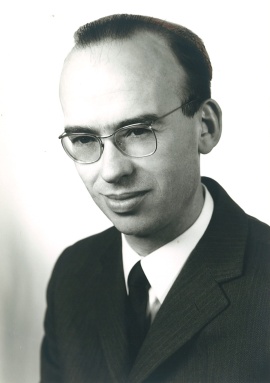
Georg Feder (Editor)
Prof. Dr. Georg Feder was born on 30.11.1927 in Bochum and died on 11.12.2006 in Cologne. He studied composition in Bochum and was the head of stage music at the theatre there from 1947 to 1949. From 1949 he read musicology, philosophy and history in Tübingen, Göttingen and Kiel. He was awarded his doctorate in 1955 with a thesis on Arrangements of Bach’s works.
From 1957 to 1992 Feder worked at the Joseph Haydn-Institut, and was Head of Research there for thirty years. One of the foremost Haydn scholars of his time and an undisputed authority in the field of music philology, he greatly shaped the work of the Institute, especially its work on the Haydn Complete Edition, making a significant contribution towards its global reputation.
54 volumes of the Complete Edition were published under his direction, eight of which he himself worked on as editor or co-editor. In addition, he edited several Urtext editions following the text in the Complete Edition for G. Henle Publishers, including Haydn’s Piano Sonatas (also an edition with selected sonatas and a study edition) as well as several volumes of string quartets (individual parts and study scores). In 1965 Feder launched the Haydn Studies as a second series published by the Joseph Haydn-Institut, publishing several important essays on the transmission of Haydn’s work in the series.
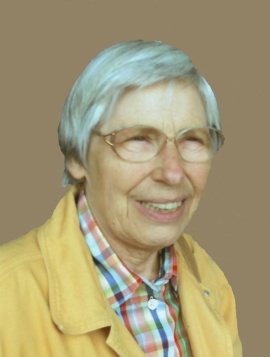
Sonja Gerlach (Editor)
Sonja Gerlach was born in Hannover in 1936. She did a secondary school teaching degree (Staatsexamen) in music and mathematics in Berlin. From 1965 to 1999 she was a research associate and editor at the Joseph Haydn-Institut in Cologne. In addition to her work as an editor and researcher she addressed questions concerning the chronology of Haydn’s symphonies. She is also very interested in problems of ascertaining authenticity of works in Haydn’s different genres.
In 2000 she retired and moved to Munich where she now lives.
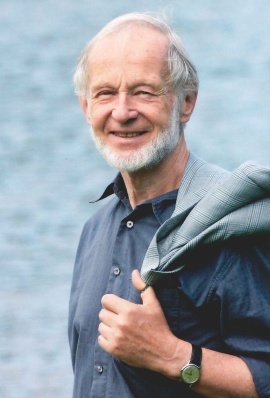
Horst Walter (Editor)
Dr. Horst Walter, born in 1931 in Hannover, studied musicology, German and philosophy at the University of Cologne. In 1962 he completed his doctorate with a thesis on the musical history of Lüneburg and that same year became a research associate at the Joseph Haydn-Institut.
From 1992 until his retirement he was its Head. He made numerous contributions to Haydn research, including articles of a biographical documentary and bibliographic nature. Horst Walter died on 4 April 2016.
James Webster (Editor)
Prof. Dr. James Webster, born on 13.09.1942 in Evanston (Illinois) did his doctorate in 1974 at Princeton University, where he studied with Sessions, Strunk, Mendel, Cone and Lockwood. Since 1971 he has taught at Cornell University (Ithaca, N.Y.), where he was appointed professor in 1982. He has been a visiting professor at Columbia and Brandeis Universitites and has held several teaching appointments in Germany.
Amongst the honours he has received, the most prominent include a Fulbright grant, fellowships from the NEH, a Guggenheim Fellowship, a Research Fellowship from the Alexander von Humboldt Foundation and the Einstein and Kinkeldey Awards of the American Musicological Society. He was President of the AMS (1997–98) and has been a member of the Joseph Haydn-Institut (Cologne) since 1979, and since 1998 a member of its board. Webster’s interests include the music of the 18th and 19th centuries in German-speaking countries, with a special focus on Haydn’s life, work and influence. In addition, instrumental music from 1750, the operas of Mozart and those of the 18th century, Beethoven, Schubert and Brahms, as well as editorial practice, the historiography of music and musical aesthetics.
Product Safety Informations (GPSR)

G. Henle Verlag
Here you can find the information about the manufacturer of the product.G. Henle Verlag e.K.
Forstenrieder Allee 122
81476 München
Germany
info@henle.de
www.henle.com
Sta volgendo al termine l’anno dedicato (anche) al 200° anniversario della morte di Franz Joseph Haydn. Tra le numerose iniziative in campo editoriale, segnaliamo quella della casa tedesca Henle: il compimento della nuova edizione di tutti i quartetti per archi (più o meno 70) di Haydn, “Papà” di questo genere e di tutto il Classicismo viennese. Sono 12 volumi in formato da studio, da conservare in un practico cofanetto.
Sunoare, 2009Man meint, aus der offiziellen Verlagsmitteilung einen gewissen Stolz auf die vollbrachte Leistung herauszulesen - und der ist durchaus berechtigt.
Ensemble, 2009Der Einband und die hervorragende Papierqualität versprechen Dauerhaftigkeit. Das Notenbild ist überschaubar. Dies alles ist nicht nur dem professionellen Musiker willkommen sondern befriedigt auch die Bedürfnisse derer, die sich nicht beruflich, sondern aus Liebe zur Musik mit den Meisterwerken beschäftigen, die selbst musizieren oder nur mit den Notenausgaben in der Hand Musik hören. Mit recht sind die Studien-Editionen im ganzen Europa ausserordenlich beliebt und zum Glück auch in Ungarn erhältlich.
Gramofon, 2009recommendations
autogenerated_cross_selling
Further editions of this title


